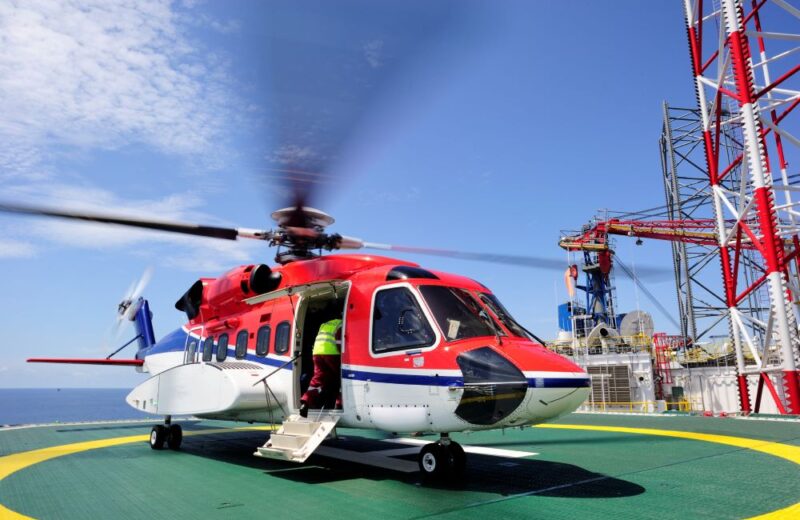HI Uplift: What hundreds of new North Sea O&G licences may mean

A new bonanza of oil and gas exploration in the North Sea? Or little impact for a time-limited industry? How are UK government plans to award hundreds of new production licences likely to influence the helicopter industry? It sounds like a happy hunting ground for lucrative new contracts. But the reality could prove different.
Our story begins late last month when Prime Minister Rishi Sunak pledged to “power up” the UK by issuing hundreds of new exploration licences and a new carbon capture scheme. “We’re choosing to power up Britain from Britain and invest in crucial industries such as carbon capture and storage, rather than depend on more carbon intensive gas imports from overseas – which will support thousands of skilled jobs, unlock further opportunities for green technologies and grow the economy,” said Sunak on Monday, July 31st.
The new oil and gas licensing rounds – subject to a climate compatibility test – will begin this autumn with the release of at least 100 production licences. This initiative will increase the UK’s energy security and reduce dependence on higher-emission imports, whilst protecting more than 200,000 jobs in a vital industry, according to the government and the North Sea Transition Authority. (Domestic gas production has about one-quarter the carbon footprint of imported liquified natural gas, they claim based on new research).
The move has been condemned by environmentalists, but is it significant for the offshore helicopter market? Steve Robertson, founder of consultancy Air & Sea Analytics puts the initiative into context. Licensing rounds are held every few years and it’s not unusual for hundreds of blocks to be awarded, with 113 licences issued in the previous (32nd) round in 2020, he says.
“This is in no way a transformational event for the UK industry – other than it does confirm at least that the government is not going to slam the brakes on the industry in the same way that countries, such as Denmark, have done,” he tells Helicopter Investor.
The UK is a mature offshore producing region, with peak production reached 24 years ago at just over 2.5m barrels per day (bpd). Production has since dwindled to 750,000 bpd. “Whilst there are still opportunities to drill for untapped sources of oil, these tend to be smaller deposits that are often produced through existing infrastructure,” says Robertson.
Jeremy Parkin, founder, aviation consultancy, Parapex Media shares Robertson’s pragmatism. “On the face of it, the statement should provide some stability for the UK offshore helicopter industry over the next few years,” Parkin tells us. “However, the UK is in an unpredictable political situation and if the majority party changes at the next General Election, then a new prime minister will be under significant pressure to reverse the decision as soon as possible.”
Air & Sea Analytics says what really moves the needle in terms of helicopter demand is the construction of new, manned infrastructure, both in the construction phase and over the lifetime of the field. “At the moment there are very few such new developments of this nature in the UK and existing platform infrastructure is gradually being decommissioned and removed,” says Robertson. He highlights the slow decline in the number of S-92s active in recent years although this has been partly off-set using super-medium types and particularly the H175. “Nevertheless, if you look at the activity levels of the main Aberdeen operators, some of them are still flying far fewer flights than they were pre-Covid,” he adds.
The UK is unusual in that the oil and gas fleet is entirely comprised of modern, twin engine types, which are capable of being flown in compliance with latest industry standards. “The distances flown from Aberdeen and Sumburgh are such that only the S-92, H175 and AW189 are capable of doing the work,” he continues. “From Norwich (in the Southern North Sea) the distances are smaller (as are many of the helidecks) and the AW139 type dominates along with a number of H175 flights. There is still activity in the Liverpool Bay which is supported by NHV mostly with the light-twin AW169.”
Parkin, at Parapex Media, highlights the significance of the government’s forthcoming decision on the Rosebank oil field, 80 miles west of Shetland. If it goes ahead, he thinks this represents an exciting prospect, which will require about four helicopters to support it. The largest untapped oil field in the UK, production could start as early as 2026, he says. “Run by a consortium led by Norwegian major Equinor, this one field will boost UK production by 8% with an additional 69,000 barrels a day compared with the most recently published annual figure for 2021 of 874,000 barrels.”
Although it’s clear oil and gas production needs to fall in the medium- to long-term in order to meet the declared national net-zero target by 2050, there’s still a need for a short-term production. This should increase over the next three to five years as the UK seeks to improve its energy security by eliminating its current dependency on imports of oil, gas and coal, according to Parapex.
Meanwhile, Robertson, at Air & Sea Analytics, sums up how Sunak’s initiative will impact the helicopter industry with a handy canine simile. “I don’t think the current announcement will have much, if any, impact on helicopter activity in the near term. However, it does give hope that the ‘tail end’ of UK oil and gas will look more like a Labrador than a Pug.”
If you enjoyed reading this Helicopter Investor Uplift newsletter, please sign up for your free copy and send this link to colleagues.






